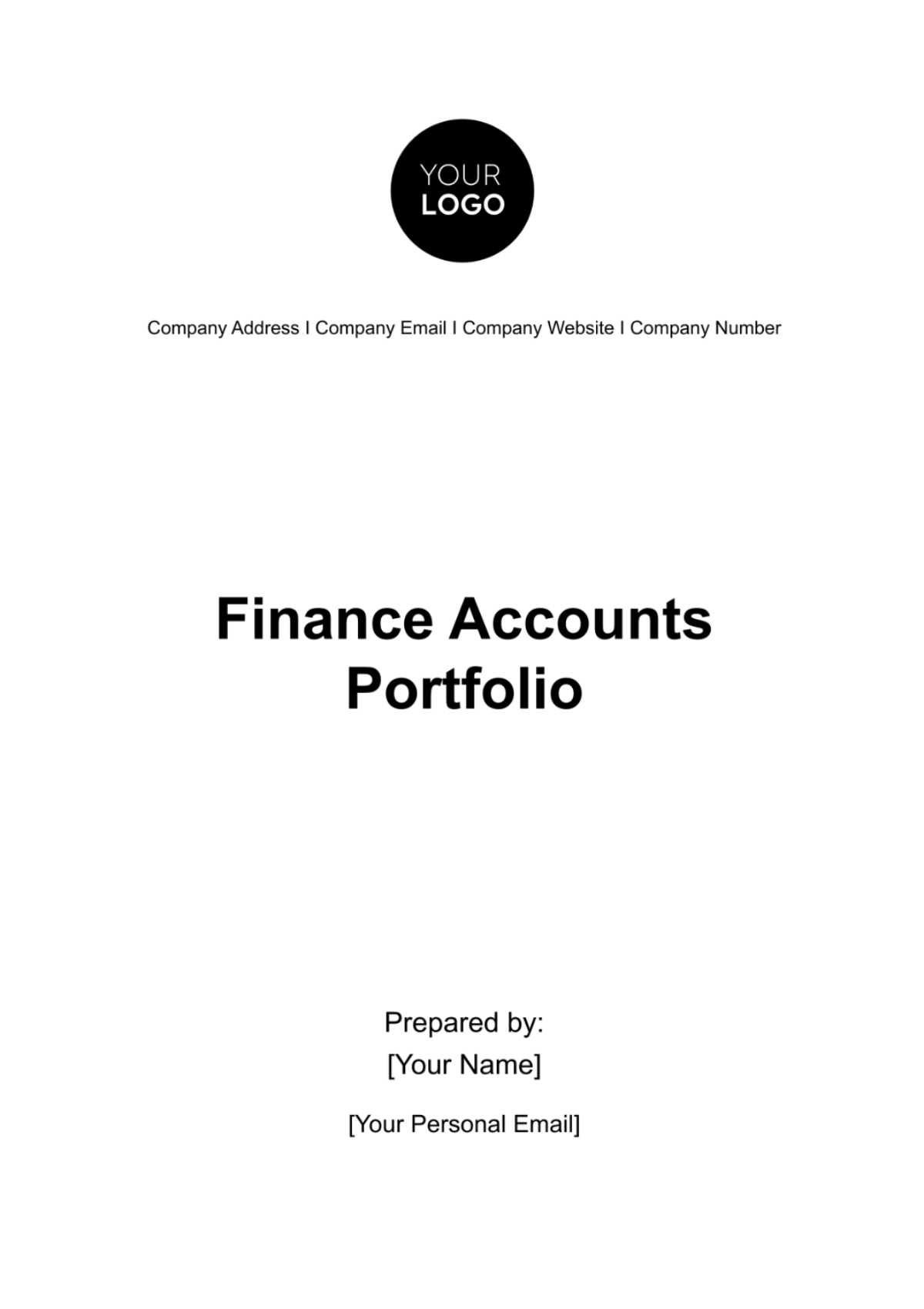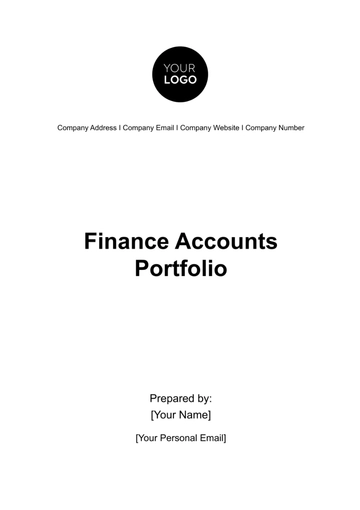Free Finance Accounts Portfolio

I. Investment Policy Statement
A. Primary Objectives
Our investment strategy revolves around two primary objectives:
First, to achieve a balanced combination of capital growth and income generation.
Second, to deliver a consistent 10% annualized return over the next five years. This return is earmarked for funding imminent capital projects and ensuring reliable dividend payouts to shareholders.
B. Time Horizon
Short Term (0-6 months)
Maintaining a liquid reserve equivalent to six months of operational expenses is our short-term focus. This ensures readiness to meet immediate financial obligations and navigate short-term challenges.
Medium Term (3-5 years)
Over the next three to five years, our goal is to build a robust capital reserve to facilitate strategic acquisitions. This timeframe aligns with our medium-term financial objectives and growth initiatives.
Long Term (10 years and beyond)
Looking ahead a decade, our long-term horizon centers on wealth preservation and retirement fund growth for employees. This extended perspective guides the formulation of our investment decisions over the long run.
C. Risk Tolerance
Our risk tolerance is characterized by a moderate appetite for risk. This acknowledges a strategic balance between stability and growth. The IPS defines acceptable limits for market volatility and articulates our approach to managing credit risk through a preference for investment-grade securities.
D. Liquidity Management
Short Term Liquidity (0-6 months)
A commitment to maintaining a liquid reserve equivalent to six months of operating expenses addresses short-term liquidity needs. This reserve ensures readiness to handle immediate financial obligations and unexpected challenges.
Medium Term Liquidity (3-5 years)
Our medium-term liquidity strategy accommodates the financial requirements of upcoming capital projects, ensuring the availability of funds for strategic initiatives.
Long Term Liquidity (10 years and beyond)
Long-term liquidity considerations are embedded in our strategy, addressing the funding needs of employee retirement plans. This ensures a systematic and sustainable approach to long-term financial commitments.
II. Asset Allocation Strategy
The graph below showcases the strategic allocation of assets:
Effective asset allocation is a cornerstone of portfolio management, influencing overall risk and return. Strategic allocation to different asset classes, as outlined in this section, allows us to diversify risk and optimize returns. The target allocation for equity is 40%. This allocation is strategically positioned to capture potential capital growth. It reflects a moderate-risk approach, balancing the potential for higher returns associated with equities against the volatility inherent in this asset class.
III. Risk Management Framework
Risk management is crucial for safeguarding our portfolio against unforeseen events. The table below showcases our risk management framework focusing on risk identification and assessment:
Risk Factor | Impact Level (1-5) | Likelihood Level (1-5) | Mitigation Strategy |
[Market Volatility] | [4] | [3] | [Diversification across sectors and geographies] |
The impact level of market volatility is rated at 4, signifying a significant impact, while the likelihood level is 3, indicating a moderate likelihood. To mitigate this risk, we employ a strategy of diversification across sectors and geographies, spreading out our investments to minimize the impact of market fluctuations. By quantifying impact and likelihood levels, we prioritize risk factors and tailor mitigation strategies. This proactive risk management framework enhances our ability to navigate challenges, ensuring the resilience and stability of our portfolio.
IV. Interest Rate and Currency Risk Management
A. Strategies for Managing Interest Rate Risk
Duration Matching
To align the portfolio with expected interest rate movements, we will maintain an average duration of 5 years, diversifying maturities across short-term and long-term securities for flexibility in response to rate trends.
Interest Rate Swaps
We will actively manage exposure through interest rate swaps, employing fixed-for-floating rate swaps to hedge against potential interest rate increases and ensure stability in the fixed-income component.
Economic Outlook
Regularly monitoring economic indicators such as GDP growth and inflation rates, our strategy involves adjusting the portfolio's interest rate exposure based on forecasts. We will shift towards shorter-duration securities in response to predicted increases in inflation.
B. Strategies for Managing Currency Risk
Hedging Instruments
Our approach to implementing currency hedging strategies involves using forward contracts to lock in exchange rates, minimizing the impact of currency fluctuations on international investments.
Diversification
Leveraging currency diversification entails holding positions in multiple currencies. We will strategically allocate a percentage of the portfolio to currencies with historically low correlation.
V. Credit Risk Management
A. Policies for Managing Credit Risk
Investment Grade Focus
Prioritizing investments in bonds rated BBB or higher, our focus on credit ratings like AAA or AA aims to maintain a high-quality portfolio.
Diversification Across Issuers
Diversifying credit risk involves limiting exposure to a single issuer to 5% of the portfolio, thereby mitigating overconcentration and potential defaults.
Regular Credit Reviews
Conducting quarterly credit reviews will involve reassessing the creditworthiness of each issuer promptly and adjusting the portfolio as needed in response to signs of deterioration.
B. Credit Quality Standards and Diversification Guidelines
Credit Quality Standards
Requiring that at least 80% of the fixed-income portfolio consists of bonds with credit ratings of A or higher, we maintain a stringent standard for creditworthiness.
Diversification Guidelines
Setting a rule that no more than 20% of the portfolio is allocated to a single industry ensures broad diversification and minimizes sector-specific risks.
VI. Investment Research and Analysis
A. Findings
Fundamental Analysis
Through rigorous fundamental analysis, key findings include robust financial health, consistent earnings growth, and alignment with industry trends. These results inform our investment decisions, ensuring a comprehensive understanding of the intrinsic value and growth potential of each asset.
Technical Analysis
Technical analysis reveals significant patterns and indicators in price trends, trading volumes, and historical market data. These findings guide our decisions on optimal entry and exit points, enhancing the timing of our investment decisions.
Risk-Return Profiles
Results from risk-return profile assessments highlight investments with favorable risk-adjusted returns. This process quantifies potential returns against associated risks, allowing us to prioritize investments that align with our risk tolerance and return objectives.
B. Mitigation Strategies
Diversification Across Asset Classes
To mitigate concentration risk, findings from our analysis underscore the importance of maintaining a well-diversified portfolio across various asset classes. This strategic approach ensures that the impact of poor performance in one sector is offset by positive performance in others, enhancing overall portfolio stability.
Continuous Monitoring and Adjustment
Findings emphasize the need for a dynamic approach, prompting continuous monitoring of existing investments. This allows us to promptly adjust our portfolio in response to changes in market conditions, mitigating potential losses and capitalizing on emerging opportunities.
Utilization of Derivatives for Risk Hedging
Our analysis identifies specific risks that can be mitigated through the strategic use of derivative instruments. Options or futures contracts may be employed to hedge against adverse movements in commodity prices or currency exchange rates, safeguarding the portfolio from potential losses.
Stress Testing
Regular stress testing allows us to identify vulnerabilities and implement preemptive measures to mitigate the impact of unforeseen events.
VII. Performance Measurement and Reporting
A. Key Performance Indicators (KPIs)
Return on Investment (ROI)
ROI serves as a fundamental KPI, quantifying the profitability of the portfolio. Calculated by dividing the net gain from investments by the initial cost, this metric provides a clear measure of the portfolio's financial performance.
Volatility Index
The Volatility Index is a critical KPI assessing the stability of the portfolio. A lower volatility index indicates a more stable investment, while higher volatility may suggest increased risk. This metric aids in understanding the level of fluctuation in the portfolio's value over time.
Sharpe Ratio
The Sharpe Ratio is a vital KPI for evaluating the risk-adjusted performance of the portfolio. It measures the excess return per unit of risk, providing insights into whether the portfolio is delivering adequate returns relative to the level of risk taken.
Beta Coefficient
Beta Coefficient is a key KPI gauging the portfolio's sensitivity to market movements. A beta of 1 indicates the portfolio moves in tandem with the market, while a beta greater than 1 suggests higher volatility. This metric aids in understanding the portfolio's systematic risk.
B. Reporting
Regular Performance Reports
Periodic performance reports are comprehensive, encompassing analyses of the aforementioned KPIs. These reports provide stakeholders with a detailed overview of the portfolio's financial health, stability, risk-adjusted performance, and sensitivity to market changes.
Ad Hoc Reporting for Significant Events
Ad hoc reporting is triggered in response to significant market events or deviations from expected performance, incorporating insights from KPIs. This ensures timely communication and transparency, allowing stakeholders to stay informed about the portfolio's status during critical junctures.
Stakeholder Meetings
Scheduled stakeholder meetings provide a forum for detailed discussions on portfolio performance, strategy adjustments, and future outlook. These discussions are informed by the findings from KPI analyses, fostering collaboration and alignment of expectations among all stakeholders.
Benchmark Comparison
In addition to internal KPIs, regular benchmark comparisons are included in performance reports. Benchmarking against relevant market indices helps contextualize the portfolio's performance, providing a reference point for assessing its competitiveness in the broader market.
Attribution Analysis
Attribution analysis will be incorporated to dissect the sources of portfolio performance. This granular examination identifies the impact of various factors such as asset allocation, security selection, and market timing on overall returns, facilitating a deeper understanding of performance drivers.
VIII. Continuous Improvement Strategies
A. Performance Review Committees
Regular Committee Meetings
Performance Review Committees will convene regularly every month to assess the effectiveness of investment strategies. These meetings involve in-depth discussions on performance reports, KPI analyses, and the impact of market dynamics on the portfolio.
Strategy Adjustment
Committees will provide recommendations for strategy adjustments based on performance reviews. This proactive approach ensures that the portfolio remains adaptable to changing market conditions and aligned with overarching financial goals.
B. Research and Development Initiatives
Technological Advancements
Continuous improvement involves leveraging technological advancements in portfolio management. This includes adopting cutting-edge tools for real-time tracking, advanced analytics, and risk modeling, enhancing the precision of decision-making processes.
Incorporating Behavioral Finance Insights
The integration of behavioral finance insights enhances decision-making processes. Understanding the psychological factors influencing market behavior allows for more nuanced portfolio adjustments, mitigating the impact of behavioral biases.
IX. Future Outlook and Strategic Direction
Continuous monitoring of emerging market trends will be integral to our strategic approach to our portfolio. We recognize the importance of analyzing evolving economic, geopolitical, and technological dynamics to inform our future investment decisions. In line with our commitment to adaptability, dynamic asset allocation will play a key role in navigating changing market conditions. Additionally, we are poised to integrate sustainable investing practices, aligning our portfolio with the growing emphasis on environmental, social, and governance (ESG) considerations. As part of our forward-looking strategy, we are exploring innovative investment vehicles to ensure our portfolio remains well-positioned for sustained success in the dynamic financial landscape.
- 100% Customizable, free editor
- Access 1 Million+ Templates, photo’s & graphics
- Download or share as a template
- Click and replace photos, graphics, text, backgrounds
- Resize, crop, AI write & more
- Access advanced editor
Showcase your financial prowess with ease with our editable Finance Accounts Portfolio Template, a standout resource on Template.net! This customizable solution, enriched by our AI Editor Tool, allows for seamless presentation and creation. Professionally exhibit your financial achievements, leaving a lasting impression on clients and stakeholders. Access your ally now!





























